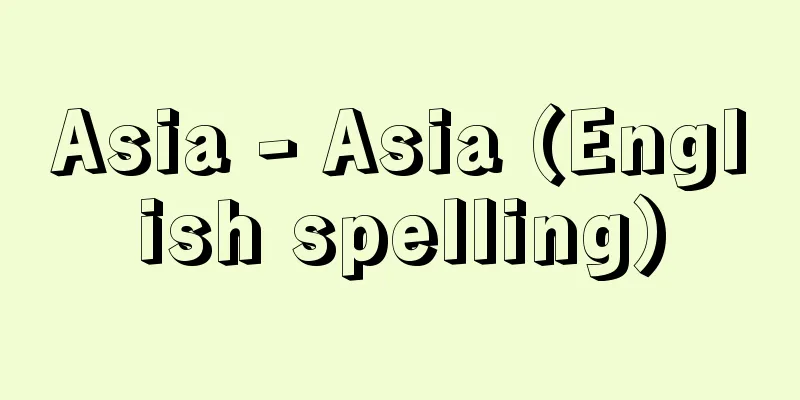Asia - Asia (English spelling)

OverviewThe origin of the name Asia is said to be when the Phoenicians, who flourished in the eastern Mediterranean in ancient times (around the 11th to 7th centuries BC), called the area east of that area Asu (the place where the sun rises) and the area west of that area Ereb (the place where the sun sets), which was the beginning of the names Asia and Europe. Asia occupies the northern part of the Eastern Hemisphere and is made up of most of the eastern and central parts of Eurasia, the world's largest continent, and the surrounding islands. It is bounded by the Arctic Ocean to the north, the Pacific Ocean to the east, and the Indian Ocean to the south, and is bordered by Europe to the west by the Ural Mountains, the Caspian Sea, the Caucasus Mountains, the Black Sea, and the Mediterranean Sea, and by Africa to the Mediterranean Sea, the Suez Canal, the Red Sea, and the Indian Ocean. This vast region covers an area of about 50 million square kilometers (about 28 million square kilometers excluding the former Soviet Union), accounting for about one-third of the world's land area, and has a population of about 3.5 billion (including the former Soviet Union), about half of the world's population (1995 United Nations estimate). Asia is usually divided into six regions: North Asia, Central Asia, East Asia, Southeast Asia, South Asia, and West Asia. However, these regions have very different and diverse topography, climate, and other climatic conditions. According to Matsuda Hisao, Asia can be divided into three climatic zones: (1) Subhumid Asia (or cold Asia. Forest region = North Asia), (2) Dry Asia (or desert Asia. Desert region = Central Asia and West Asia), and (3) Humid Asia (or monsoon Asia. Monsoon region = East Asia, Southeast Asia, and South Asia). These climatic conditions are said to have shaped the history of each region, with hunting lifestyles in subhumid Asia, nomadic lifestyles and oasis lifestyles in dry Asia, and agricultural lifestyles and marine lifestyles (coastal areas and islands) in humid Asia. Thus, taking into account both human and geographical conditions, Matsuda divides Asia into the following four major cultural regions. These are: (1) the East Asian agricultural cultural sphere centered on China; (2) the South Asian agricultural cultural sphere centered on India; (3) the North Asian nomadic cultural sphere; and (4) the West Asian oasis cultural sphere, where Iranian (Persian) and Islamic cultures were dominant. [Okakura Koshiro] Changing Concepts of AsiaAs mentioned above, Asia and Europe respectively refer to the region where the sun rises (East) and the region where the sun sets (West) with the eastern Mediterranean as the coordinate axis. The same idea is seen in the Latin origin of the words Orient and Occident, which also refer to sunrise and sunset, respectively. In Japanese, they are translated as East and West. However, in this case, the Orient generally refers to the so-called Near East countries from the Western European perspective, and in Western history it particularly refers to ancient Egypt and Mesopotamia (the ancient Orient), so it is narrower than Asia, the East, and the Orient as mentioned above. This narrower sense of the Orient should rather be called the "Middle Ocean," which corresponds to the aforementioned West Asia and oasis cultural sphere. Therefore, the original Asia includes both the Orient in the narrow sense, which is the Orient in the broad sense, and the Orient with the "Middle Ocean" removed from it, and the "Middle Ocean." In other words, broadly speaking, Asia consists of two parts: the East Asian cultural sphere (China and India) and the West Asian cultural sphere (Mesopotamia), and religiously these correspond to the Buddhist world and the Islamic world. However, apart from the ancient and medieval periods, after the Age of Discovery (15th-16th centuries), Western countries began to invade Asia, and by the late 18th century many Asian countries had been colonized. Furthermore, when the era of industrial capitalism gave way to the era of imperialism, the colonization of Asia was completed. This caused the social and economic development of Asia to stagnate, and Asia, although it had great ancient civilizations, came to be seen as a "backward region" that lagged behind in development. One reflection of this image of Asia is, for example, the names Far East, Middle East, and Near East. The Far East refers to Northeast Asia, the Middle East to West Asia, and the Near East to the Balkan Peninsula and Turkey, but these are names based on the United Kingdom and reflect the British colonial and imperialist stance. However, with the independence of colonies and the progress of national liberation movements after the Second World War, the image of colonial Asia changed, and Asia came to appear on the world political and economic stage as a major component of the developing "Third World." Of course, although Asian countries have achieved political and national independence, apart from Japan, many countries have lagged behind in economic development, and in some cases, even today, half a century after the war, many have been unable to completely escape economic subordination to advanced capitalist countries such as Europe and the United States. However, one thing is certain: the image of Asia as it was before the war has completely changed. [Okakura Koshiro] Ancient Civilizations and AsiaAsia is a place where humans first appeared 500,000 to 600,000 years ago. The first humans currently identified in Asia are said to be the Java Man (Pithecanthropus erectus) and the Peking Man (Sinanthropus pekinensis), who used stone tools and knew about fire. Homo erectus was eventually replaced by the more evolved Homo sapiens. About 10,000 years ago, the Neolithic Age arrived, and humans transitioned from a hunting and gathering lifestyle to farming and pastoralism, settling down and living in different regions. During this process, clans, which were ties of blood, developed and tribal societies were formed. With the development of productivity, the division of labor progressed, and classes such as aristocrats and slaves were created, and rulers with political power (kings who were the descendants of gods) appeared based on political and religious class systems and religious authority. Then, separate from the countryside, grand public buildings and densely populated cities emerged, and the first human civilizations emerged. Ancient civilizations flourished around the mid-40th century BC in the basins of great rivers where intensive agriculture was practiced and social development as mentioned above was progressing. As is well known, these are the four regions of (1) the lower Tigris-Euphrates River Basin, (2) the Nile River Basin, (3) the Indus River Basin, and (4) the Yellow River Basin. All of them except (2) the Nile River Basin belong to Asia. The civilizations that flourished in the Tigris-Euphrates River Basin flourished in the Mesopotamian (and then Elamite) region, especially in the two great kingdoms of Babylonia and Assyria. The oldest civilization in India flourished in a vast area, including Harappa and Mohenjo-daro in the Indus River Basin, from the mid-25th century BC to the mid-15th century BC, but was eventually destroyed by the Aryans who migrated south from Central Asia and southern Russia. The Aryans adopted agriculture, settled down, and formed an ancient unified autocratic state based on Brahmanism, producing excellent literature such as the Rig Veda, Ramayana, and Mahabharata. In China, ancient civilization flourished during the Yin Dynasty (16th to 11th century BC), which rose in the Yellow River basin (Anyang), and then the Zhou Dynasty (11th to 8th century BC). After that, through the Spring and Autumn Period and the Warring States Period, autocratic unified states appeared, including the Qin Dynasty, the Western Han Dynasty, and the Eastern Han Dynasty. However, due to invasions by northern tribes and other events, the country was divided into the Wei, Jin, Northern and Southern Dynasties, and finally unification was achieved by the Sui and Tang dynasties. The Tang Dynasty in particular became a great global empire by the 7th century, bringing about the development of agriculture and industry and the rise of culture. [Okakura Koshiro] The Establishment of the Medieval WorldAround the middle of the 7th century, the vast Saracen Empire was formed under the doctrine of Islam, spanning Asia, Europe, and Africa, and Saracen culture flourished. The influence of the Saracen Empire's expansion of the Islamic world reached India, and eventually the unified Indian dynasty was Islamized, leading to the founding of the Mughal Empire. The Mughal Empire lasted from the early 16th century to the middle of the 19th century, during which time culture flourished remarkably under the rule of emperors such as Akbar the Great (1542-1605) and Aurangzeb (1618-1707). Meanwhile in China, the Song Dynasty arose after the Tang Dynasty, and a centralized bureaucratic state system was established, but it was destroyed by the Mongols in the late 13th century. The Mongols then built the great Yuan Dynasty, spanning Asia and Europe, and traffic and cultural exchange between the East and the West was greatly promoted. Later, the Ming and Qing dynasties replaced the Yuan dynasty in China, and the Ottoman Empire arose in Western Asia. However, the so-called Age of Discovery in the 15th and 16th centuries marked a turning point, as European powers began to invade Asia, causing the collapse of Asian feudal despotism one after another and the decline into societies under colonial rule. [Okakura Koshiro] Asia under colonial ruleThe Age of MercantilismAs mentioned above, in the 15th and 16th centuries, the Western powers began to invade not only Asia but also Latin America and various parts of Africa. In the first half of the 16th century, Portugal advanced eastward from the Red Sea to the Persian Gulf, then from India to Southeast Asia, occupying Malacca, and further advancing to Guangdong (Canton), Macau, and Japan. Meanwhile, Spain advanced westward, passing through the Americas and Latin American countries, and advancing into the Philippines. Portugal and Spain gained enormous profits through piracy, slave trade, and spice monopoly. However, the annexation of Portugal by Spain (1580) and the subsequent destruction of the Spanish "Invincible Armada" by the British Navy marked the end of the era of Portuguese and Spanish colonial monopoly, and first the Netherlands and then the United Kingdom emerged in their place. The Netherlands acquired Java, Malacca, Ceylon, and other islands, and then traded with China and Japan. Britain gained control of Chennai (Madras), Mumbai (Bombay), and Kolkata (Calcutta) in India, and made them military and trade bases. Later, France also advanced into India and Indochina. During this time, there were several military conflicts between Britain and the Netherlands and France, but these wars further strengthened Britain's position. In the early 17th century, Britain, the Netherlands, and France all established organizations called East India Companies, which engaged in direct violence, oppression, plunder, and exploitation. For example, Britain used violence and deception to buy local produce in India at a quarter of the price, and in return sold British goods at five times the price, imprisoning Indians who resisted. They also forced Indian farmers to grow poppies to export opium to China. As a result, the East India Company's annual dividend rate is said to have reached 100-200%. Thus, over the centuries from the Age of Discovery to the late 18th century, many parts of Asia were colonized by Western powers. As a result, Asian societies were inevitably drawn into a process of rapid change and collapse, and were forced to fall into colonial and feudal societies. On the other hand, the enormous profits made in this way flowed back to Western Europe, becoming a source of original accumulation of capital, and promoting the development of capitalism in Western countries. In response, the people of Asia resisted with uprisings of various sizes, such as the rebellions in Java (1512), Ambon (1635), and Madura (1674) in Indonesia, and the famous series of Maratha Wars in India (late 18th century). Although these resistance wars were the initial forms of wars of national liberation, they were mainly led by feudal rulers and in many cases were defeated due to internal conflicts and other reasons. [Okakura Koshiro] The era of industrial capitalismFrom the second half of the 18th century to the end of the 19th century, the Western powers' invasion of Asia became much more widespread and their social and economic impacts much more serious. This was because the Industrial Revolution led to large-scale industrial production, which required the acquisition of large quantities of cheap raw materials and foodstuffs, and the securing of markets for the sale of industrial products. Thus, India was completely under British colonial rule by 1856, and Burma (now Myanmar), Ceylon (now Sri Lanka), Malaya (now Malaysia), Singapore, Cochinchina (southern Vietnam), Afghanistan, Iran, Turkey, and others also became colonies or dependent states of the Western powers one after another. China also began to follow the path of semi-colonization after its defeat in the Opium Wars (1840-1842), and Japan was forced to sign unequal treaties by the great powers. As a result, most of Asia came under colonialism, and became a complement to Western capitalism, a source of raw materials and food supplies for the great powers, and a market for selling goods. The traditional subsistence economy was dismantled and forced into the mold of a colonial monoculture economy, with serious consequences for peasants, artisans and even feudal rulers. Inevitably, many ethnic rebellions broke out in response to this. Representative examples include the Báb Rebellion (1848-1852, Persia), the Indian Mutiny (Sepoy Mutiny, 1857-1859), and the Taiping Rebellion (1850-1864, China). Historically, these ethnic rebellions were the initial stage of Asian national liberation movements and the last anti-colonial movements under the leadership of the feudal ruling class. Furthermore, these movements were defeated due to the limitations of their leadership, but at the same time, the fact that they influenced each other, albeit indirectly, was the beginning of solidarity among Asian ethnic groups in later times. [Okakura Koshiro] The Age of ImperialismWith the beginning of the era of imperialism and monopoly capitalism in the 1870s, the imperialist powers, including the later imperialist powers such as the United States, Germany, Russia, and Japan, became fierce in their competition to seize colonies, and by the beginning of the 20th century, the imperialist powers had completed their final division of the globe. Under this imperialist colonial system, Asia, Africa, and Latin America were completely incorporated into the framework of the world capitalist economy as sources of raw materials, food, and cheap labor, and as export markets for goods and capital. However, the expansion and strengthening of colonial rule inevitably sharpened the contradictions between imperialism and oppressed nations, and this was the beginning of the full-scale launch of the modern national liberation movement, that is, the movement aimed at realizing the right of national self-determination. Examples include the Constitutional Revolution in Iran (1905), the Young Turk revolution and the overthrow of autocracy in Turkey (1908), the establishment of the goals of Swaraj (independence) and Swadeshi (use of domestically produced goods) by the Indian National Congress Party (1906), the formation of nationalist organizations Budi Utomo in Indonesia (1908) and Sarekat Islam (1911), and the formation of the Kuomintang in the Philippines (1907). In China, the Xinhai Revolution took place (1911) with Sun Yat-sen's Three Principles of the People (nation, people's livelihood, and people's rights) as its platform, overthrowing the autocratic rule of the Qing Dynasty and establishing the Republic of China. Many of these movements were led by so-called bourgeois nationalists. The First World War and the Russian Revolution had a decisive impact on these Asian national independence movements, including the March 1st Independence Movement in Korea, the May 4th Movement and the May 30th Movement in China (1925), the Indonesian anti-Dutch national uprising (1926), the start of the first nonviolent and non-cooperation movement by the Indian National Congress under the leadership of Gandhi (1919), Afghanistan's third anti-British war and the acquisition of independence, and Egypt's anti-British independence struggle and the realization of a measure of independence (1922). The chain reaction explosion of these movements was due to the principle of national self-determination advocated by U.S. President Wilson at the Paris Peace Conference after World War I and other events, which provided a justification for encouraging nationalists in Asian countries, while the Soviet Union, established by the Russian Revolution, implemented a policy of encouraging complete self-determination of ethnic groups both at home and abroad. Furthermore, in the 1920s, Comintern branches were established one after another in Asian countries, and Communist Parties, representing the interests of workers and peasants, emerged as a driving force for a thorough anti-imperialist and anti-feudal revolution. As the global economic depression of the 1930s bore down on the peoples of Asia's colonies and semi-colonies, and Japanese imperialism's war of aggression expanded into East Asia and Southeast Asia, the issues of anti-fascism and national liberation gradually became intertwined, leading to the deepening and development of the national liberation movement. [Okakura Koshiro] The dawn of an era of independence and revolutionBackground to the rise of the independence movement The rise of national liberation movements in Asian colonies and dependent countries after the Second World War began earlier than in other continents, almost simultaneously with the end of the war, and by the end of the 1940s, many of them had gained independence. The conditions for this were, first, the military victories of Japanese imperialism over the imperialisms of the United States, Britain, France, and the Netherlands in the early stages of the Pacific War, which led to the collapse of their colonial rule systems, the military confrontations between the imperialist countries which weakened each other, and finally, the defeat of Japanese imperialism, which created a vacuum in colonial rule. Second, the influence of the Soviet Union in the international situation increased, which checked Western imperialism. Third, the formation of a national liberation united front to wage the anti-fascist (anti-Japanese) national liberation war (under the leadership of the Communist Party in China, Vietnam, the Philippines, etc.). These objective and subjective conditions came together under the victory of the anti-fascist war, which led to the explosion and victory of the national liberation movement like a storm. (Note that the following descriptions do not include the so-called Middle East. Therefore, please refer to the respective entries for the "Palestinian problem," "Middle East war," and "Gulf War.") The collapse of the colonial systemIn 1945, immediately after the end of the Pacific War, Vietnam, Indonesia, and other countries declared independence, followed by the Philippines in 1946, India and Pakistan in 1947, and Burma (now Myanmar) and Ceylon (now Sri Lanka) in 1948. After the war, the former Japanese territory of Korea, which was under UN trusteeship, created South Korea to the south of the 38th parallel and North Korea to the north. Another important event was the victory of the Chinese revolution in October 1949, and the establishment of the People's Republic of China. During this time, France and the Netherlands attempted to recolonize Indochina and Indonesia through military invasions, but were defeated. Thus, the collapse of the colonial system in most of Asia, including a population of over a billion people, in just five years after the war was a truly world-historic event. This had a major impact on the rise of national liberation movements and the achievement of independence in West Asia (Iraq, Iran, etc.), North Africa (Egypt, the three Maghreb countries), and even sub-Saharan Africa. During this time, countries such as China, North Korea, and Vietnam, where the Communist Party played a leading role in the victory of their national liberation revolutions, founded their nations along the socialist path and joined the socialist camp along with Mongolia and other Asian republics that were members of the former Soviet Union. The former Soviet Union, China, and North Korea also formed military alliances with each other, while the United States concluded military treaties with Japan, South Korea, Taiwan, the Philippines, Thailand, and other countries and stationed U.S. troops in those countries. Thus, the "Cold War" between the capitalist camp led by the United States and the socialist camp led by the former Soviet Union intensified into "hot wars" in Asia, such as the Indochina War (1946-1954) and the Korean War (1950-1953), and even raised the fear that it could become the fuse for the Third World War that would engulf all of Asia. [Okakura Koshiro] The Five Principles of Peace and the Asian-African ConferenceConcerned about the situation, the prime ministers of five Southeast Asian countries (India, Burma, Ceylon, Pakistan, and Indonesia) met in Colombo in May 1954 and issued a declaration calling for self-restraint from the United States, Britain, and the Soviet Union. In June 1954, Prime Ministers Zhou Enlai and Nehru declared that the "Five Principles of Peace" (mutual respect for sovereignty and territory, mutual non-aggression, non-interference in each other's internal affairs, equality and mutual benefit, and peaceful coexistence) should be universal principles for relations between all nations to guarantee friendly relations between China and India. Thus, the Indochina ceasefire was realized with the Geneva Accords in July of the same year, and the crisis was temporarily averted. However, shortly thereafter, the United States talked with Britain and France into forming the Southeast Asia Treaty Organization (SEATO), an anti-communist military bloc that included Thailand, the Philippines, and Pakistan, and also began providing military support to South Vietnam in place of France. It was under these circumstances that the Asian-African Conference was held in Bandung, Indonesia in April 1955, co-hosted by the five Colombo Group countries, and attended by presidents and prime ministers from 29 countries, including China and Japan, regardless of whether they were members of the Eastern or Western military blocs, and unanimously adopted a declaration including the "Ten Principles of Peace" (also known as the Bandung Ten Principles), which incorporated the UN Charter and the "Five Principles of Peace" in the spirit of "seeking common ground while respecting differences." The Bandung Conference was the first epoch-making event in world history where newly independent countries that had escaped colonial rule united to demonstrate their presence in the international community, promoting the independence of unliberated colonies and becoming the starting point of the Non-Aligned Movement in later years. [Okakura Koshiro] Neocolonialism and the Vietnam WarIn order to continue colonial control and exploitation of resources and markets after the collapse of the colonial system, the Western powers began to adopt a strategy called neo-colonialism in the 1960s. This strategy relies on a variety of means and methods, including the maintenance of dependent reactionary governments through military aid and military alliances, seizure of power through military coups, economic and technical assistance through government loans and investments by multinational corporations, food aid, control, infiltration, and the exercise of influence over education, culture, and the media through financial and economic assistance from international organizations such as the International Bank for Reconstruction and Development (World Bank), the International Monetary Fund (IMF), the International Development Association (IDA, commonly known as the Second World Bank), and the Organization for Economic Cooperation and Development (OECD). The aim is to make the independence of newly independent countries a mere name and to reduce them to de facto dependent nations. In Asia in the 1960s and 1970s, the United States implemented neo-colonial policies such as dividing nations and ethnic groups and dominating one side of them (Korea, Taiwan, Vietnam), establishing U.S. military bases through the collective military alliance SEATO and individual military alliances with Japan, Taiwan, South Korea, the Philippines, Thailand, South Vietnam, and other countries, stationing U.S. troops, and infiltrating, dominating, and plundering their economies through economic aid. However, by its very nature, neo-colonialism will increase dissatisfaction among the people of the target country over poverty and human rights violations, making it inevitable that they will engage in a struggle against the puppet regime. When this happens, the mask comes off and the true nature of colonialism is revealed, leading to military oppression and wars of aggression. The Vietnam War of 1964-1975 is a good example of this. The United States first tried to suppress the armed uprising of the people by supporting the puppet army of South Vietnam in a "special war," but this failed. Eventually, the United States bombed North Vietnam, used chemical weapons, deployed large numbers of U.S. troops (540,000 at its peak), and expanded its invasion to Laos and Cambodia, but in the end, it suffered defeat by respecting the self-determination of the three Indochinese countries and allowing U.S. troops to withdraw. Despite using roughly half of its land, naval and air forces, a war budget of $240 billion, and the use of three times as much artillery and bombs as used during World War II, the complete defeat of the world's most powerful nation at the hands of the resistance of the small Vietnamese government and people and the global anti-war and peace movement was a truly world-historic event. [Okakura Koshiro] ASEAN and Asian NIESThe unification of North and South Vietnam into a powerful socialist nation in June 1976, and especially the invasion of Cambodia by the Vietnamese army at the end of 1978, heightened the sense of crisis in neighboring Southeast Asian countries, and prompted the revitalization of ASEAN (Association of Southeast Asian Nations). Originally, ASEAN was a regional cooperation organization formed in 1967 in the midst of the Vietnam War by five countries, the Philippines, Thailand, Malaysia, Singapore, and Indonesia, most of which were under developmental dictatorships at the time. While supporting the US's Vietnam War, it also showed a tendency toward neutrality, and did not achieve much apart from declaring a neutral zone in 1971. However, after the Vietnam War in 1976, it held its first summit meeting and concluded the Treaty of Amity and Cooperation in Southeast Asia, and after the Cambodian conflict in 1977, it established an expanded foreign ministers' conference with the addition of Japan and the US. The background to this revitalization was that most of the member countries had achieved rapid economic growth during this time, strengthening themselves. Brunei then joined after gaining independence in 1984, followed by Vietnam, which had shifted to economic liberalization through the "Doi Moi" (reform) policy, and was accepted as a member along with Laos, doubling the number of countries to nine in the 30 years since ASEAN was formed. Cambodia then officially joined in April 1999, realizing the ASEAN-10 structure. The economies of East and Southeast Asian countries, excluding Japan, underwent dramatic change and growth from the mid-1960s, especially from the 1970s onwards. First, the four Asian NICS (Newly Industrializing Countries, later renamed NIES, Newly Industrializing Economies) - South Korea, Taiwan, Hong Kong and Singapore - followed by China, Thailand, Malaysia and Indonesia recorded astonishing economic growth rates (GDP growth rates). The average annual growth rate of these eight countries from 1965 to 1990 was 5.5%, 6.7% for East Asia as a whole and 3.8% for Southeast Asia, both of which exceeded the OECD average of 2.7%. The reason for this growth was the shift from the former colonial economy's pattern of exporting primary products and importing manufactured goods to investment by multinational corporations and export-oriented industrialization using low-wage labor. In the 1990s, economic growth also progressed in South Asian countries such as India and Vietnam, which had lagged behind. However, the structural weaknesses of the foreign capital-dependent, export-oriented industrialization strategy under developmental dictatorship that had brought about this economic growth were exposed with the devaluation of the Thai currency, the baht, in 1997, causing a serious currency and economic crisis that spread throughout Asia, making fundamental reforms inevitable. [Okakura Koshiro] Today's issues and challengesThus, Asia has undergone great transformations in the half century since the end of World War II. The biggest changes were the collapse of the imperialist colonial system and the emergence of newly independent nations. This was a landmark event not only in Asian history but also in world history. However, today Asia is faced with many serious unresolved problems and issues, including not only problems that could be considered the aftereffects of the colonial era, but also new problems that have arisen since the war. It is not possible to mention all of these, but I will list some of the most important ones. First of all, there are issues relating to war and peace. Three major wars that took place around the world in the second half of the war, namely the Korean War (1950-1953), the Vietnam War (1964-1975), and the Gulf War (1991), all took place in Asia. In addition, there are also small and medium-sized wars that involved conflicts over ethnic, religion and territory, such as the Israeli-Arab War, the Iran-Iraq War, and the India-Pacific War. During the so-called Cold War, conflicts between the US and the Soviet Union and their respective military blocs and bilateral military alliances were the background to these wars, and a large number of US forces intervened in the name of the UN and alliances. Even after the Cold War, when the military blocs disappeared and the Soviet Union collapsed, the US organized multinational forces to carry out the Gulf War, and continued to bomb Iraq. In response, emerging independence countries in Asia have already taken an stance of defending peace and independence by not participating in the US and Soviet camps since the 1950s, and the aforementioned Ten Principles of Peace was included in the aforementioned Ten Principles of Peace, but when the leaders of India Nehru and Indonesian Soukarno joined the founders, many countries joined in the non-aligned movement, and Pakistan, the Philippines, and Vietnam, which later left the military alliance, joined in. Today, with the exception of a small number of countries such as Japan, China, and South Korea, most Asian countries are participating in the non-aligned movement, with the exception of the United Nations, striving to abolish nuclear weapons, disarmament, democratization of the United Nations, and realize a new international economic order with just and equality. になったんです。 English: The first thing you can do is to find the best one to do. Many Asian countries have worked together with other non-aligned countries to strive to realize the abolition of nuclear weapons and banning the use of nuclear weapons, such as at the UN General Assembly and the Disarmament Conference in Geneva, but in ASEAN, the efforts of Malaysian Prime Minister Mahathir and others, and in December 1995, 10 countries, including seven members at the time, including Myanmar, Laos and Cambodia, signed the Treaty of Nuclear-Free Zones, which entered into force in 1997 (Laos and Myanmar in 1997, and Cambodia in 1999). From this point on, North and South Korea also issued a declaration of denuclearization of the Korean Peninsula in 1991, and in 1997 the former Soviet republics of Kyrgyzstan, Kazakhstan and Tajikistan also agreed to a nuclear-free Zone Planet. Next are the issues that relate to the core of economic and social development: independent economic construction, rapid population growth, poverty and environmental issues. Emerging Asian countries have been working to build their economy in various ways, aiming to escape from the non-modern and subordinate colonial economic structures that have been developed after achieving independence, and overcome poverty, hunger, no rights, and ignorance, which are the aftermath. As a result, although there is a new form of resource and market control by multinational corporations, they have achieved incredible economic development, such as East Asia, Southeast Asian countries, and even China and India, which have shifted to the "modernization" line. However, due to the weakness of foreign capital dependence, a serious economic crisis spreads since 1997, and if the United States is left to the management and supervision of the IMF (International Monetary Fund), the path for voluntary economic development will be closed. になったんです。 English: The first thing you can do is to find the best one to do. Poverty has been resolved rapidly in NIES countries, but gaps between rich and poor have widened. In addition, over the past 30 years, half of Asian forests and a third of all cultivated land have deteriorated over the past 30 years, half the catches of marine fisheries have been reduced, the slums of megacities and worsening urban pollution, and air and water pollution have also progressed. Thus, "Asian environment is on the verge of collapse, right now," said the Asian Development Bank. になったんです。 English: The first thing you can do is to find the best one to do. [Okakura Koshiro] Asia and JapanNeedless to say, Japan is a member of Asia, and the Japanese have been strongly influenced by cultures such as China, Korea, India for thousands of years within the Asian cultural sphere, and have been absorbed and developed their own cultures by absorbing them. In the 19th century, Asian ethnic groups were invaded by Western powers and were colonized one after another, but Japan overcome the crisis of colonization with the Meiji Restoration. This was thanks to the anti-colonial and anti-feudal struggles of Asian ethnic groups, such as the leaders of the Meiji Restoration and the people, but also because the anti-colonial struggles of Asian ethnic groups, such as the Rebellion of the Taiping Heaven and the Great Indian Rebellion, made the Western powers experience bitter experience and become wary. However, after the Meiji Restoration, Japan set out on the path of modernization to catch up with the Western powers, aiming for rapid capitalism by expanding into neighboring countries, expanding its sphere of influence, and acquiring markets, raw materials, and resources. As a result, the "Koa theory" (along with China, Korea, etc., which corresponds to Europe and Europe in cooperation with China, Korea, etc.) before and after the Meiji Restoration, replaced the "De-Asia-European Theory" (Fukuzawa Yukichi), and the theory of coalition with Asian peoples on the liberal rights and left was replaced by the expansion of national rights and the Great Asianism of Asia, which invaded Asia. Thus, Japan seized Taiwan and Korea through the Sino-Japanese and Russo-Japanese wars, and quickly joined the ranks of imperialist countries. Furthermore, after the First World War, in the 1930s, it began charging towards militarism and external invasion in order to overcome the blows caused by the World Economic Depression and the contradictions of domestic society. The concept of the Greater East Asia Co-Prosperity Sphere was actually nothing more than a concept where Japanese imperialism would replace Western powers and control Asian ethnic groups, and aim to ensure their own country's wealth and prosperity. It is a symbol of this that the Nanjing Massacre and the comfort women issue occurred during this process. As a result of the defeat in 1945 (Showa 20), Japanese imperialism and militarism collapsed, and they were placed under the occupation of the Allied powers, and in fact the US. On the other hand, Asian ethnic groups became independent and a new Asia was born. After the establishment of the Peace Treaty with Japan (1952), Japan was unable to escape military and economic subordinate to the United States (revised in 1960), and is still under the US nuclear strategic regime. In particular, after the collapse of the Soviet Union, the "Guidelines for Japan-US defense cooperation" (new "Guidelines") in line with the US's global strategy was agreed in September 1997, and Japan is positioned as a collaborator in American military intervention in Asian countries. Since the 1950s, Japan's economic reconstruction and unusually high economic growth have made Japan the world's second largest economy, but the majority of Japan's public foreign aid has been concentrated in Asia, and its multinational corporations have also oriented towards controlling the resources, markets and low-wage labor in East and Southeast Asia. And, as a whole, these have played a complementary role in the framework of America's neocolonialist Asian strategy. In this situation, it is no surprise that Asian countries fear a recreation of the Greater East Asia Co-Prosperity Sphere and the revival of Japanese militarism. It is first necessary for the Japanese government to officially recognize the erroneous attitudes that Japan has taken towards Asian ethnic groups since the Meiji period, namely the strict historical facts of colonial rule over Korea, Taiwan, invasion and occupation of China and Southeast Asian countries, oppression and exploitation, and to reflect on this, sincerely apologize, make sincere apologies, and make a pledge to not repeat such mistakes again in the future. Next, based on the Great Principles of Permanent Peace of the Constitution of Japan, the National Constitution will legislate the "Three Nuclear-Free Principles," which are considered national policy, and strive to withdraw from the United States from the "nuclear umbrella," abolish nuclear weapons, and realize a nuclear-weapon-free zone in the East Asia, as well as a related measure to abolish the Japan-US military alliance, remove the US military base, and establish a non-aligned and neutral position. Furthermore, in terms of economic terms, the public foreign aid (ODA) should be reviewed, and the content is intended to help Asian countries truly develop economically and improve the lives of the peoples, and efforts should be made to reform the nature of the IMF, the World Bank, and the Asian Development Bank, which play a neocolonial role, and provide equal and equal cooperation and support to Asian countries, such as by regulating the tyranny of multinational corporations. This is the path that Japan, an economic powerhouse in Asia, should take. [Okakura Koshiro] "NHK Civic University Series 21: History of Asia" by Matsuda Hisao (1971, Nippon Broadcasting Publishing Association)" ▽ "Contemporary History of Asia" 5 volumes compiled by the Historical Research Society (1981, Aoki Shoten)" ▽ "Asia: Challenge to Change" by Asian Development Bank, translated by Yoshida Tsuneaki (1998, Toyo Keizai Shinposha)" [Reference items] | | | | | | | | | | | | | | |©Shogakukan "> Colonial Asia (1900) Source: Shogakukan Encyclopedia Nipponica About Encyclopedia Nipponica Information | Legend |
総説アジアという名称の起源は、古代(前11~前7世紀ごろ)地中海東部に栄えたフェニキア人が、その地より東方の地域をアスAsu(日の出る地方)、西方をエレブEreb(日の沈む地方)とよんだのが、アジアおよびヨーロッパの名称の始まりであるという。 アジアは東半球の北部を占め、世界最大の大陸であるユーラシア大陸の大部分(東部および中部)にあたる大陸部と周辺の島々とからなっている。北は北極海、東は太平洋、南はインド洋に囲まれ、西はウラル山脈、カスピ海、カフカス山脈、黒海、地中海によりヨーロッパと、また地中海、スエズ運河、紅海、インド洋によりアフリカとそれぞれ接している。この広大な地域の面積は約5000万平方キロメートル(旧ソ連領を除くと約2800万平方キロメートル)で世界の陸地面積の約3分の1を占め、また人口は約35億人(旧ソ連領を含む)で世界人口の約2分の1に上る(1995国連推計)。 アジアは北アジア、中央アジア、東アジア、東南アジア、南アジア、西アジアの6地域に分類されるのが普通であるが、これらの地域は地形、気候など風土的条件が非常に異なり、多種多様である。松田壽男(ひさお)によれば、アジアは〔1〕亜湿潤アジア(または寒冷アジア。森林地帯=北アジア)、〔2〕乾燥アジア(または砂漠アジア。砂漠地帯=中央アジアおよび西アジア)、〔3〕湿潤アジア(またはモンスーン・アジア。モンスーン地帯=東アジア、東南アジア、南アジア)の三つの風土帯に分けられる。そして、これらの風土的条件に規制されて、亜湿潤アジアには狩猟生活型が、乾燥アジアには遊牧生活型とオアシス生活型が、また湿潤アジアには農耕生活型および海洋生活型(沿海部と島嶼(とうしょ)部)が、それぞれ歴史の基盤となったとされている。こうして、松田は人文、地文の両条件を踏まえて、アジアを次の四大文化圏に分けて考察する。すなわち、〔1〕中国を中心とした東アジア農耕文化圏、〔2〕インドを中心とする南アジア農耕文化圏、〔3〕北アジア遊牧文化圏、〔4〕イラン(ペルシア)やイスラムの文化が支配的だった西アジア・オアシス文化圏である。 [岡倉古志郎] アジアの概念の変遷前述したように、アジアとヨーロッパとは、地中海東部を座標軸にして、それぞれ日の出る地方(東方)および日の没する地方(西方)を意味した。これと同一の発想は、オリエントOrientとオクシデントOccidentの語源となるラテン語にもみられ、やはり日の出と日没がそれぞれの語意である。邦訳すれば東洋と西洋ということになる。ただしこの場合のオリエントは一般的には西欧からみてのいわゆる近東諸国をさし、また西洋史学ではとくに古代のエジプト、メソポタミア(古代オリエント)をさすから、前述のような意味におけるアジア、東方、東洋よりは狭義になる。この狭義のオリエントはむしろ「中洋」ともいうべきであって、それは前述の西アジア・オアシス文化圏に対応する。それゆえ、本来のアジアは、広義の東洋、東方から「中洋」を除去した狭義の東洋と「中洋」とを包含したものになるわけである。つまり、大きく分ければ、アジアは東アジア文化圏(中国およびインド)と西アジア文化圏(メソポタミア)の二つの部分からなり、宗教的にはこれらは仏教世界およびイスラム世界ということになる。 しかし、古代、中世にかけては別として、大航海時代(15~16世紀)以降、西欧諸国のアジアへの侵入が始まり、18世紀後半までにはアジアの多くの国々が植民地化され、さらに、産業資本主義の時代から帝国主義の時代になるとアジアの植民地化は完了する。これによってアジアの社会的、経済的発展は停滞させられ、アジアは偉大な古代文明をもちながらも、発展の後れた「後進地域」としての概念でとらえられるに至った。このようなアジア像の一つの反映は、たとえば極東、中東、近東という呼称である。極東はほぼ東北アジアを、中東はほぼ西アジアを、近東はバルカン半島諸国とトルコをそれぞれさすが、これらはイギリスを基点にした呼称であって、イギリスの植民地主義的、帝国主義的な立場を反映するものである。しかし、第二次世界大戦後の植民地の独立、民族解放運動の前進に伴い、植民地アジアのイメージは変貌(へんぼう)し、アジアは発展途上の「第三世界」の有力な構成部分として世界政治、経済の舞台に登場するに至った。もちろん、アジア諸国は政治的、国家的独立を成し遂げたとはいえ、日本を別とすれば経済的発展の立ち後れや、国によっては欧米など先進資本主義諸国に対する経済的従属を脱しきれぬ国々が戦後半世紀の現在でも少なくない。しかし、戦前までのアジア像が一変したことだけは確かである。 [岡倉古志郎] 古代文明とアジアアジアは50万~60万年以前に早くも人類が出現した地である。すなわち、アジアで現在確認されている最初の人類はジャワの直立猿人(ピテカントロプス・エレクトゥス=ジャワ原人)および中国の北京(ペキン)原人(シナントロプス・ペキネンシス)であるとされ、石器を使用し、北京原人は火を知っていたという。やがてホモ・エレクトゥスはより進化したホモ・サピエンスによってとってかわられた。約1万年前、新石器時代が到来し、人類は狩猟・採集生活から農耕・牧畜生活に移行、定着して生活を営むようになるが、このような過程のなかで血縁的結合である氏族が発達し、部族社会が形成された。生産力の発展に伴い分業が進み、貴族―奴隷という階級が発生し、政治的、宗教的な階級制度や宗教的権威に基づいて政治権力をもつ支配者(神の子孫たる王)が出現した。そして、農村から分離した壮大な公共建築物と稠密(ちゅうみつ)な人口をもつ都市が出現し、人類最初の文明が登場した。 古代文明は紀元前40世紀なかばごろ、いずれも農業が集約的に行われ、前述のような社会的発展が進んでいる大河の流域に開花した。これらは周知のように〔1〕ティグリス・ユーフラテス川下流域、〔2〕ナイル川流域、〔3〕インダス川流域、〔4〕黄河流域の四つの地域で、〔2〕のナイル川流域を除きすべてアジアに属する。ティグリス・ユーフラテス川流域に開花した文明は、メソポタミア(ついでエラム)地域、とくにバビロニアとアッシリアの両大王国で栄えた。インド最古の文明は、インダス川流域のハラッパー、モヘンジョ・ダーロなどをはじめ広大な地域にわたって、前25世紀なかばから前15世紀なかばにかけて開花したが、やがて中央アジア、南部ロシアから南下してきたアーリア人に滅ぼされた。アーリア人は農耕化して定住し、バラモン教を基礎とする専制的古代統一国家を形成、『リグ・ベーダ』、『ラーマーヤナ』、『マハーバーラタ』などの優れた文学をも生み出した。中国では黄河流域(安陽)に興隆した殷(いん)王朝(前16世紀~前11世紀)、ついで周王朝(前11世紀~前8世紀ごろ)に古代文明が開花したが、その後、春秋戦国時代を経て、秦(しん)王朝、前漢、後漢と続く専制統一国家が現れた。しかし北方民族の侵入などを契機に、魏(ぎ)、晋(しん)、南北朝へと分裂時代が続き、ようやく隋(ずい)、唐により統一が実現した。とくに唐は7世紀ごろには世界的な大帝国となり、農工業の発達と文化の興隆をもたらした。 [岡倉古志郎] 中世世界の成立7世紀なかばごろ、イスラム教の教義のもとでアジア、ヨーロッパ、アフリカにまたがる広大なサラセン帝国が形成され、サラセン文化が興隆した。サラセン帝国によるイスラム圏の拡大の影響はインドにも及び、やがてインド統一王朝のイスラム化が実現、ムガル帝国が建立された。ムガル帝国は16世紀初頭から19世紀なかばまで続くが、その間アクバル大帝(1542―1605)、アウランゼーブ帝(1618―1707)などの治下で文化が目覚ましく栄えた。一方中国では、唐のあとに宋(そう)朝が興り、中央集権的官僚国家体制が確立するが、13世紀後半にはモンゴル人よって滅ぼされた。モンゴル人はその後アジアからヨーロッパにまたがる大帝国の元(げん)を建設し、東西間の交通、文化の交流は著しく促進された。その後中国では元にかわって明(みん)、清(しん)が、西アジアではオスマン・トルコ帝国が興った。しかし、15~16世紀のいわゆる大航海時代を転換期として、ヨーロッパの列強はアジアへの侵略を開始し、これによりアジア的封建専制国家は相次いで崩壊し、植民地支配下の社会へと転落し始めることになる。 [岡倉古志郎] 植民地支配下のアジア重商主義の時代前述のように、15~16世紀にかけて西欧列強はアジアばかりでなくラテンアメリカ、アフリカの各地域に侵入し始めた。16世紀前半、ポルトガルは紅海からペルシア湾、ついでインドから東南アジアにまで東進してマラッカを占領し、さらに広東(カントン)、マカオ、日本にまで進出した。一方、スペインは西回りで進み、アメリカ大陸、ラテンアメリカ諸国を経て、フィリピンに進出した。ポルトガルやスペインは海賊、奴隷貿易、香料の独占などにより莫大(ばくだい)な利益を手に入れた。しかし、スペインによるポルトガルの併合(1580)、ついでスペインの「無敵艦隊」のイギリス海軍による壊滅を契機にして、ポルトガルとスペインの植民地独占の時代は終わりを告げ、かわって、まずオランダ、ついでイギリスが登場するに至った。オランダはジャワ島、マラッカ、セイロン島などを手に入れ、ついで中国や日本とも交易した。イギリスはインドのチェンナイ(マドラス)、ムンバイ(ボンベイ)、コルカタ(カルカッタ)を手中に収めてここを軍事、貿易の拠点とした。遅れてフランスもインド、インドシナに進出した。この間、イギリスとオランダ、フランスとの間には数次の軍事衝突も生じたが、これらの戦争を通じてイギリスの地歩はいっそう強化された。 17世紀初頭、イギリス、オランダ、フランスはいずれも東インド会社という組織を設けて、直接的な暴力、抑圧、劫掠(ごうりゃく)と収奪を行った。たとえば、イギリスはインドで、暴力と欺瞞(ぎまん)により現地生産物を4分の1の価格で購入、逆にイギリス商品を5倍の価格で売りつけ、これに反抗するインド人を投獄した。また、インド農民に対して中国へのアヘンの輸出のためケシを強制栽培させたりした。その結果、東インド会社の年間配当率は100~200%にも上ったといわれる。こうして、大航海時代から18世紀後半に至る数世紀間に、アジアの多くの地域が西欧列強によって植民地化された。その結果、アジア社会はいやおうなしに急速な変化、崩壊の過程に引き込まれ、植民地的、封建的社会に転落させられていった。他方、こうしてあげられた膨大な利益は、西欧に還流して資本の本源的蓄積の源泉となり、西欧諸国における資本主義の発展を促進した。これに対して、アジアの民衆は大小さまざまの蜂起(ほうき)で抵抗した。たとえばインドネシアではジャワ島(1512)、アンボン島(1635)、マドゥラ島(1674)における反乱が、またインドでは数次にわたる有名なマラータ戦争(18世紀末)などが起こっている。これらの抵抗戦争は民族解放戦争の端緒的形態ではあるが、主として封建的支配者の指導によるもので、多くの場合、内部対立などの原因によって敗北した。 [岡倉古志郎] 産業資本主義の時代18世紀後半から19世紀末にかけて、西欧列強のアジア侵略は従来よりも範囲がいっそう広くなり、また、その社会的、経済的影響がずっと深刻になった。これは産業革命の結果、大規模な工業生産が行われるようになり、大量かつ安価な原料、食料品の獲得と工業製品の販売市場の確保が必要になったためである。こうして、インドは1856年までに完全にイギリスの植民地支配下に置かれ、ビルマ(現ミャンマー)、セイロン(現スリランカ)、マレー(現マレーシア)、シンガポール、コーチシナ(ベトナム南部)、アフガニスタン、イラン、トルコなども、相次いで西欧列強の植民地、従属国となった。中国もアヘン戦争(1840~1842)での敗北を契機に半植民地化の道をたどり始め、日本も列強から不平等条約を押し付けられた。この結果、アジアの大部分が植民地主義のもとに置かれ、列強の原料、食料品供給の源泉および商品販売市場として、西欧資本主義の補完物となるに至った。伝統的な自給自足経済は解体され、植民地的モノカルチュア(農作物の単一栽培)経済の鋳型に押し込まれ、農民、手工業者や封建的支配者までも深刻な影響を被った。 これに対して多くの民族的反乱が起こったのは必然的であった。バーブ教徒の反乱(1848~1852、ペルシア)、インドの大反乱(セポイの反乱、1857~1859)、太平天国の乱(1850~1864、中国)などはその代表的なものである。歴史的にみれば、これらの民族的反乱はアジアの民族解放運動の初発的段階のものであり、封建支配層指導下の反植民地主義運動の最後のものであった。また、これらの運動はその指導力の限界性のゆえに敗北するが、同時に間接的ながら相互に影響しあっていたことは、後の時代のアジア諸民族の連帯の萌芽(ほうが)でもあった。 [岡倉古志郎] 帝国主義の時代1870年代以降の帝国主義、独占資本主義の時代に入ると、アメリカ、ドイツ、ロシア、日本など後発の帝国主義列強も含めた、帝国主義列強間の植民地略取競争は熾烈(しれつ)化し、20世紀初頭までには帝国主義列強による地球の最終的分割が完了した。この帝国主義の植民地体制下でアジア、アフリカ、ラテンアメリカは原料、食料、低廉な労働力の供給源として、商品と資本の輸出市場として完全に世界資本主義経済の枠組みのなかに組み込まれてしまった。しかし、植民地主義の支配の拡大、強化は帝国主義と被抑圧諸民族との間の矛盾を必然的に先鋭化することになり、ここに近代的民族解放運動、すなわち民族自決権の実現を目ざす運動が本格的に開始されることになる。たとえば、イランの立憲革命(1905)、トルコの青年トルコ党の革命と専制政治の打倒(1908)、インドの国民会議派によるスワラージ(独立)、スワデーシー(国産品愛用)の目標確立(1906)、インドネシアにおける民族主義組織ブディ・ウトモ(1908)、サレカット・イスラム(1911)の結成、フィリピンにおける国民党の結成(1907)などである。中国では孫文の三民主義(民族、民生、民権)を綱領として辛亥(しんがい)革命が起こり(1911)、清朝の専制支配を倒して中華民国を樹立した。これらの運動はいわゆるブルジョア民族主義者の指導によるものが多かった。 このようなアジアの民族独立運動に決定的な影響を及ぼしたのは、第一次世界大戦とロシア革命であった。すなわち、朝鮮の三・一独立運動、中国の五・四運動、五・三〇運動(1925)、インドネシアの反オランダ全国蜂起(ほうき)(1926)、ガンジー指導下のインド国民会議派の第一次非暴力・不服従運動の開始(1919)、アフガニスタンの第三次反英戦争と独立の獲得、エジプトの反英独立闘争といちおうの独立の実現(1922)などである。これらの運動の連鎖反応的爆発は、第一次世界大戦のパリ講和会議などでアメリカ大統領ウィルソンの唱えた民族自決の原則が、アジア諸国の民族主義者たちを励ます大義名分を与えたこと、一方ロシア革命で樹立されたソ連が、内外の諸民族の完全な自決を促す政策を実行したことなどによるものである。さらに1920年代に入るとアジア諸国に相次いでコミンテルンの支部が結成され、労働者、農民の利益を代表する共産党が徹底的な反帝国主義、反封建の革命の推進力として登場してくる。 1930年代の世界経済恐慌のしわ寄せがアジアの植民地、半植民地人民のうえにのしかかるなかで、やがて、日本帝国主義の侵略戦争が東アジア、東南アジアに拡大されるに及んで、反ファシズムと民族解放の課題はしだいに結合して、民族解放運動の深化、発展をもたらすに至った。 [岡倉古志郎] 独立と革命の時代の幕開き独立運動の高揚の背景第二次世界大戦後のアジアの植民地、従属国の民族解放運動の高揚は、他の大陸のそれよりも早く、終戦とほぼ同時に始まり、1940年代末までには相次いで独立を獲得した。その条件としては第一に、太平洋戦争初期に日本帝国主義がアメリカ、イギリス、フランス、オランダ各帝国主義に軍事的に勝利し、それらの植民地統治制度がくずれたこと、帝国主義国どうしが軍事的に対決し互いに弱めあったこと、最後に日本帝国主義が敗退した結果、植民地支配に空白が生じたことがあげられる。第二に国際情勢に対するソ連の影響力が増大し、欧米帝国主義を牽制(けんせい)したこと、第三に、反ファッショ(抗日)民族解放戦争遂行のための民族解放統一戦線が結成されたこと(中国、ベトナム、フィリピンなどでは共産党の指導下で)などがある。このような客観的、主体的条件が反ファッショ戦争の勝利のもとで結び付き、嵐(あらし)のような民族解放運動の爆発と勝利をもたらしたのである。(なお、これ以下の諸項目の記述では、いわゆる中東は除いてある。したがって、「パレスチナ問題」「中東戦争」「湾岸戦争」についてはそれぞれの項目を参照されたい。) 植民地体制の崩壊1945年、太平洋戦争の終結直後、ベトナム、インドネシアなどが独立を宣言し、ついで翌1946年にはフィリピン、1947年にはインド、パキスタン、1948年にはビルマ(現ミャンマー)、セイロン(現スリランカ)が独立し、また戦後国連信託統治下にあった旧日本領朝鮮では北緯38度線の南に韓国、北に北朝鮮がつくられた。さらに重要なできごととして1949年10月中国革命が勝利して中華人民共和国が樹立された。この間フランス、オランダはインドシナ、インドネシアの再植民地化を企図して軍事侵略を行ったが敗北した。このように、戦後わずか5年間で十数億の人口を含むアジアの大部分で植民地体制が崩壊したことはまさに世界史的なできごとであった。それはやがて西アジア(イラク、イランなど)、北アフリカ(エジプト、マグレブ三国)、さらにサハラ砂漠以南のアフリカの民族解放運動の高揚と独立の達成に大きな影響をもたらした。この間、民族解放革命の勝利に共産党が指導的役割を果たした中国、北朝鮮、ベトナムなどでは社会主義の道に沿った建国が行われ、モンゴルや旧ソ連邦加盟のアジアの諸共和国とともに社会主義陣営に加わった。また旧ソ連、中国、北朝鮮は相互に軍事同盟を結び、他方、アメリカは日本、韓国、台湾、フィリピン、タイなどと軍事条約を締結し米軍を駐留させた。こうしてアメリカを盟主とする資本主義陣営と旧ソ連主導下の社会主義陣営との間の「冷戦」は、アジアでは、インドシナ戦争(1946~1954)、朝鮮戦争(1950~1953)のように「熱戦」にまで激化し、全アジアを巻き込む第三次世界大戦の導火線になる恐れさえも生み出した。 [岡倉古志郎] 平和五原則とアジア・アフリカ会議事態を憂慮した東南アジア5か国(インド、ビルマ、セイロン、パキスタン、インドネシア)の首相は1954年5月コロンボで会議を開きアメリカ、イギリス、ソ連の自制を求める宣言を発した。また、周恩来・ネルー両首相は1954年6月、中国・インド両国間の友好関係を保障すべき「平和五原則」(主権・領土の相互尊重、相互不侵略、相互内政不干渉、平等互恵、平和的共存)をすべての国家間関係の普遍的原則とすべきことを宣言した。こうして同年7月のジュネーブ協定でインドシナ停戦が実現、危機はひとまず回避された。だがアメリカはその直後イギリス、フランスを語らいタイ、フィリピン、パキスタンを含む反共軍事ブロックの東南アジア条約機構(SEATO(シアトー))を結成、またフランスにかわって南ベトナムへの軍事支援に乗り出した。 こうした情勢のもと前記コロンボ・グループ5か国共催下に1955年4月インドネシアのバンドンでアジア・アフリカ会議が開催され、東西の軍事ブロック加盟、非加盟を問わず、また中国、日本を含む29か国の大統領、首相らが参加して、「求同存異」の精神で国連憲章と「平和五原則」を盛り込んだ「平和十原則」(バンドン十原則ともいう)を初めとする宣言を全員一致で採択した。バンドン会議は植民地支配を脱した新興独立諸国が一致して国際社会に存在感を示した世界史上初の画期的できごとであり、未解放植民地の独立を促進し、また後年の非同盟運動の原点となった。 [岡倉古志郎] 新植民地主義とベトナム戦争植民地体制崩壊のなかで資源、市場などの植民地的支配と収奪を続けるため、欧米列強は1960年代に入るころから新植民地主義とよばれる戦略をとり始めた。それは軍事援助や軍事同盟による従属的反動政権の維持や軍部のクーデターによる政権奪取、政府借款や多国籍企業の投資による経済、技術援助、食糧援助、国際復興開発銀行(世界銀行)、国際通貨基金(IMF)、国際開発協会(IDA、通称第二世銀)、経済協力開発機構(OECD)などの国際機関の財政経済援助を介した支配、浸透、教育・文化・マスコミなどへの影響力の行使など多面的な手段、方法によるものであるが、要は新興独立国の独立を名ばかりのものにし事実上の従属国に転落させるのが目的である。アメリカは1960~1970年代のアジアで、国土、民族の分断とその片方の支配(朝鮮、台湾、ベトナム)、集団的軍事同盟SEATOや日本、台湾、韓国、フィリピン、タイ、南ベトナムなどとの個別的軍事同盟による米軍基地の設置、米軍の駐留、経済援助による経済浸透・支配・収奪などの新植民地主義政策を展開した。 だが、新植民地主義はその本質上、対象国人民の間に窮乏、人権侵害などへの不満をつのらせ、傀儡(かいらい)政権と敵対する闘争を必至にする。そうなると仮面がはがれて植民地主義の本質が露呈し、軍事的抑圧と侵略戦争が表面に出る。1964~1975年のベトナム戦争がその好例である。アメリカはまず南ベトナムの傀儡軍を支援して人民の武装蜂起(ほうき)を鎮圧しようとした「特殊戦争」が失敗、ついには、北ベトナムへの爆撃、化学兵器の使用、大量の米軍の投入(最盛時54万)、ラオス、カンボジアにまで侵略を拡大したが、最後にはインドシナ3国の民族自決を尊重し、米軍の撤退を認める敗北を嘗(な)めた。陸海空戦力の約半分、2400億ドルの戦費、第二次世界大戦中の使用量の3倍もの砲爆弾の使用にもかかわらず、世界最強の大国が小国ベトナムの政府、人民の抗戦と世界的な反戦平和運動の前に完全に敗北したことはまさに世界史的できごとであった。 [岡倉古志郎] ASEANとアジアNIES1976年6月南北ベトナムが統一して強力な社会主義国となったこと、とくに1978年末ベトナム軍がカンボジアを侵略したことは周辺の東南アジア諸国の危機感を募らせ、ASEAN(アセアン)(東南アジア諸国連合)の活性化を促した。元来ASEANは1967年ベトナム戦争のさなかに、当時はほとんどが開発独裁政権下にあったフィリピン、タイ、マレーシア、シンガポール、インドネシアの5か国が結成した地域協力機構で、アメリカのベトナム戦争を支持しつつも中立化傾向を示し、1971年には中立地帯宣言を発した以外にはさほどの成果もあげなかった。だがベトナム戦争後の1976年には初の首脳会議を開いて東南アジア友好協力条約を締結、カンボジア紛争後1977年には日米両国などを加えた拡大外相会議を設置した。この活性化の背景には大半のメンバー国がこの間急速な経済成長を遂げ自身を強めたこともある。その後1984年独立したブルネイが加盟、ついで「ドイモイ(刷新)」政策で経済自由化に転じたベトナムも参加を望み、ラオスとともに加盟を認められ、ASEANは結成30年で9か国に倍増した。その後1999年4月にカンボジアが正式に加盟し、ASEAN10体制が実現した。 日本を除くと東アジア、東南アジア諸国の経済は、1960年代なかば、とくに1970年代以降劇的な変化、躍進を遂げた。まずアジアNICS(ニックス)(新興工業諸国、後にNIES(ニーズ)新興工業経済地域と改称)とよばれた韓国、台湾、香港、シンガポールの4か国、続いて中国、タイ、マレーシア、インドネシアが驚異的な経済成長率(GDPの伸び率)を記録した。以上8か国の1965~1990年の年平均成長率は5.5%、東アジア全体では6.7%、東南アジアは3.8%でOECD諸国平均の2.7%を凌駕(りょうが)している。旧植民地型経済の一次産品輸出、工業品輸入というパターンが多国籍企業の投資と低賃金労働力利用の輸出向け工業化に転換したことがこの成長の要因であった。1990年代になると立ち後れていた南アジアのインドやベトナムなどの経済成長も進んだ。だが、この経済成長をもたらした開発独裁下の外資依存・輸出志向型工業化戦略の構造的弱点は1997年のタイ通貨バーツ切り下げを契機として露呈され、深刻な通貨、経済危機が全アジアに拡大し、抜本的な改革が必至となった。 [岡倉古志郎] 今日の問題点と課題このように第二次世界大戦後の半世紀間にアジアは大きく変貌(へんぼう)した。その最大のものは帝国主義の植民地体制の崩壊と新興独立国の出現である。それはアジア史のみならず世界史における画期的なできごとでもあった。だが今日、アジアは植民地時代の後遺症ともいうべき諸問題ばかりでなく、戦後新たに生じてきた問題も含めて多くの未解決の重大な問題や課題を抱えている。そのすべてに言及することはできないが重要なものをあげておこう。 まず第一は戦争と平和にかかわる問題である。戦後半世紀間に世界で起こった三つの大規模な戦争、すなわち朝鮮戦争(1950~1953)、ベトナム戦争(1964~1975)、湾岸戦争(1991)はすべてアジアで起こっている。このほか、4回にわたる中東戦争(イスラエル・アラブ紛争)、イラン・イラク戦争、印パ戦争など民族、宗教、領土をめぐる紛争にかかわる中小規模の戦争もある。いわゆる冷戦時代には米ソ両陣営の対立とそれぞれの軍事ブロックや二国間軍事同盟がこれらの戦争の背景にあり、しかも大量の米軍が国連軍、同盟軍の名のもとに介入した。軍事ブロックが消滅し、ソ連が崩壊した冷戦後になってさえ、アメリカは多国籍軍を組織して湾岸戦争を遂行し、その後もイラク爆撃を強行した。 これに対してアジアの新興独立諸国はすでに1950年代の朝鮮、インドシナ戦争のころから米ソ両陣営への不参加による平和と独立の擁護の姿勢をとり、前述の平和十原則にもその願望を盛り込んでいたが、インドのネルー、インドネシアのスカルノ両首脳も創始者に加わって1961年非同盟運動が発足すると多くの国々がこれに参加、その後軍事同盟を離脱したパキスタン、フィリピン、ベトナムも加わり、今日では日本、中国、韓国など少数を除き、ほとんどのアジア諸国が非同盟運動に参加、国連を中心に核兵器廃絶、軍縮、国連の民主化、公正平等な新国際経済秩序の実現などに向け奮闘している。 第二の問題は以上とも関連の深い核兵器の問題である。アジアで、いな世界で核兵器が最初に戦争で用いられたのは1945年8月米軍機による広島、長崎への原爆投下であった。アメリカはその後も幸い未遂に終わったがアジアにおける前述の三つの戦争で核兵器の使用を準備したし、また、在日米軍基地やアジアの諸海域に展開する米艦船に核兵器が貯蔵、搭載されていることは厳然たる事実である。こうして現在アジアにはアメリカ、ロシア(ソ連から継承)、中国の核戦力に加え、1998年にはインド、パキスタン両国が保有を公にするに至った。これにより核不拡散条約(略称NPT)の無力さが露呈されたのみか、印パ両国間の局地戦争が核戦争に突入する危険さえ現実性を帯びた。アメリカなどが誇大に騒ぐ北朝鮮やイラクの核開発はそれほどではないが、なぜか黙過されるイスラエルの相当な数の核兵器保有は疑いの余地はない。核兵器廃絶の課題はアジアではとりわけ重要な課題である。 アジアの多くの国々は他の非同盟諸国とともに国連総会やジュネーブの軍縮会議などで核兵器廃絶、使用禁止等の実現をめざして奮闘してきたが、とくにASEAN(アセアン)ではマレーシアのマハティール首相などの努力が実り、1995年12月、当時加盟7か国にミャンマー、ラオス、カンボジアの未加盟3か国を加えた10か国が東南アジア非核地帯条約に調印、1997年発効した(ラオス、ミャンマーは1997年、カンボジアは1999年にASEAN加盟)。これよりさき南北朝鮮も1991年朝鮮半島非核化宣言を発しており、また1997年にはキルギス、カザフスタン、タジキスタンの旧ソ連の諸共和国も中央アジア非核地帯構想に合意した。 つぎに経済社会発展の根幹にかかわる諸問題、すなわち自立的な経済建設、人口の激増と貧困の問題や環境問題などがある。アジアの新興諸国は独立達成後発展の後れた非近代的、従属的な植民地型経済構造からの脱却、その後遺症ともいうべき貧困、飢餓、無権利、無知などの克服をめざしてさまざまな方法で経済建設に取り組んできた。その結果、多国籍企業による新しい形の資源、市場等の支配はあるものの、たとえば1970年代以後東アジア、東南アジア諸国、さらには「近代化」路線に転じた中国やインドなどにみられるような驚異的な経済発展を遂げた。だが外資依存の弱点から1997年以後深刻な経済危機が広がり、もしもこの危機の打開をアメリカの意図するIMF(国際通貨基金)の管理監督に委ねるならば自主的な経済発展の道は閉ざされるであろう。 アジアの人口は1950年の15億人から1995年には35億人へと倍以上に激増し、増加分だけでも先進諸国の人口総計に等しい。この増加率が続けば2025年には50億人に達するものと予想されている。これは衛生、医療の改善による死亡率、とくに乳幼児死亡率の激減の結果でありそれ自体は喜ぶべきだが、経済成長ともあいまって人口の都市集中化が進み、公害やスラム化など新しい環境・社会問題を派生させている。現在、アジア人口の30%が都市に住んでいるが、2020年には50%になると予測され、現在全世界の巨大都市(人口1000万以上)14のうちアジアは9を占めるが、2015年までには27のうち18に倍増するという。これらとも関連するが、消費額1日1ドル以下の貧困層は途上国全体で約13億人、うちアジアは約4分の3で、中国3億7000万人、インドなど南アジア5億1500万人である(1993年、世界銀行調べ)。NIES諸国では貧困は急速に解消したが、貧富の格差は拡大した。また急速な経済成長に伴い過去30年間にアジアの森林の半分、全耕作地の3分の1の土壌が劣化、海洋漁業の漁獲量の半減、巨大都市のスラム化と都市公害の悪化、大気、水質汚染も進んでいる。こうして「アジアの環境は今まさに崩壊寸前という瀬戸際に立たされているのである」(アジア開発銀行)。 最後に政治的民主主義と人権の問題がある。新植民地主義の政治的形態や経済建設のあり方とも関連するが、過去半世紀の間にアジアの新興独立諸国ではさまざまな性格、形態の独裁政権(しばしば「開発独裁」とよばれる。多くは軍部によるクーデターなどの手段により樹立され、政治的な独裁を経済的発展によって正当化するもの)が出現し、なかには30年前後の長きにわたって存続した例もある(シンガポールのリー・クアン・ユー、インドネシアのスハルトなど)。しかし1980年代末ごろから民衆の不満、反発を基礎にして民主化が進み、韓国、フィリピン、タイ、シンガポール、インドネシアなどで独裁政権が崩壊、あるいは衰退した。だが、ミャンマーやイラクなどでは依然独裁政治が継続しており、また、体制の相違は別としても、共産党支配下の中国でも1989年の第二次天安門事件にみられるように政治的民主主義は確立されていない。少なくとも「国際人権規約B」の諸権利が国民に保障されるようになることが切望される。 [岡倉古志郎] アジアと日本いうまでもなく日本はアジアの一員であり、日本人はアジア文化圏のなかで数千年来、中国、朝鮮、インドなどの諸文化の影響を強く受け、またそれらを吸収しながら独自の文化を発展させてきた。19世紀になってアジアの諸民族は欧米列強に侵略され、相次いで植民地化されたが、日本は明治維新によってこの植民地化の危機を乗り越えた。これは、明治維新の指導者たちや民衆の反植民地化、反封建の闘いによるのはもちろんだが、中国の太平天国の乱、インドの大反乱など、アジア諸民族の反植民地主義の闘争が、欧米列強に苦い経験を味わわせ、警戒心を抱かせたことのおかげでもあった。 しかし明治維新後、日本は欧米列強に追いつくべく近代化の道を踏み出し、近隣諸国への進出、勢力圏の拡充、市場、原料、資源の獲得などによって、急速な資本主義の発展を目ざした。これに伴い、維新前後の「興亜論」(中国、朝鮮などと連携して欧米にあたる)は「脱亜入欧論」(福沢諭吉)にかわり、また自由民権左派のアジア諸民族との連体論は黒竜会などの国権拡張とアジア侵略の大アジア主義に取ってかわられた。こうして、日本は日清(にっしん)、日露両戦争によって台湾、朝鮮を奪い、植民地化し、急速に帝国主義国の列に加わった。さらに、第一次世界大戦を経て1930年代に入ると、世界経済恐慌による打撃や国内社会の矛盾の克服のため、軍国主義と対外侵略に向かって突進した。「大東亜共栄圏」の構想は、実は日本帝国主義が欧米列強にかわってアジア諸民族を支配し、自国の富強と繁栄を図る構想にほかならなかった。この過程で南京大虐殺事件や従軍慰安婦問題などが生じたのはその象徴である。 1945年(昭和20)の敗戦の結果、日本帝国主義、軍国主義は崩壊し、連合国、実際はアメリカの占領下に置かれることになった。他方、アジア諸民族は独立し、新しいアジアが誕生した。対日講和条約の成立(1952)後も、同時に結ばれた日米安全保障条約および新安保条約(1960改定)のもとで、日本はアメリカに対する軍事・経済従属を脱却できず、現在なお、アメリカの核戦略体制下に置かれている。とくにソ連崩壊後、アメリカの世界戦略に沿った「日米防衛協力の指針」(新「ガイドライン」)が1997年9月に合意され、日本はアメリカのアジア諸国への軍事的介入の協力者として位置づけられている。 1950年代なかば以降、日本の経済的復興と異例な高度経済成長により、日本は世界第二の経済大国になったが、日本の対外公的援助の大半はアジアに集中し、また、その多国籍企業も東アジア、東南アジアの資源、市場、低賃金労働力の支配を指向している。そして、これらが全体として、アメリカの新植民地主義的アジア戦略の枠組みのなかで、補完的役割を果たしている。このような状況のなかで、アジア諸国が「大東亜共栄圏」の再現と日本軍国主義の復活を恐れるのも無理からぬことである。 明治以降、日本がアジア諸民族に対してとってきた誤った態度、すなわち朝鮮、台湾への植民地支配と中国、東南アジア諸国への侵略と占領、抑圧と収奪などの厳然たる歴史的事実を日本国政府が公式に認識し、これに対する反省と真摯(しんし)な謝罪、誠意のある国家補償を行うとともに今後このような過ちを再び繰り返さないという誓約を行うことがまず必要とされる。次に日本国憲法の恒久平和の大原則に基づき、また国是とされる「非核三原則」を法制化し、アメリカの「核の傘」からの離脱、核兵器の廃絶、東アジア非核兵器地帯の実現などに努めるとともに、これと関連して日米軍事同盟の廃止、在日米軍、同軍事基地の撤去、非同盟・中立の立場を確立するための措置を講ずることが必要である。さらに経済面では対外公的援助(ODA)を見直し、アジア諸国の真の経済発展と諸国民の生活向上に役立つ内容のものに改め、新植民地主義的役割を演じているIMFや世界銀行、アジア開発銀行などのあり方の改革に努力し、多国籍企業の横暴を規制するなどアジア諸国への対等・平等な協力、支援をすべきである。これこそアジアの一員たる経済大国日本が進むべき道である。 [岡倉古志郎] 『松田壽男著『NHK市民大学叢書21 アジアの歴史』(1971・日本放送出版協会)』▽『歴史学研究会編『アジア現代史』全5巻(1981・青木書店)』▽『アジア開発銀行著・吉田恒昭監訳『アジア 変革への挑戦』(1998・東洋経済新報社)』 [参照項目] | | | | | | | | | | | | | | |©Shogakukan"> 植民地時代のアジア(1900年) 出典 小学館 日本大百科全書(ニッポニカ)日本大百科全書(ニッポニカ)について 情報 | 凡例 |
<<: Afro‐Asian Conference - Asia-Africa Conference (English name)
Recommend
Proconsul - Proconsul (English spelling)
A family of fossil apes. Since the 1930s, skulls,...
Cutting oil - Sessakuyu (English spelling) cutting oil
Oils used for lubrication, cooling, and corrosion...
Common base word - Kyotsuukigo
…Linguistics is a science that deals with languag...
Levy, L.
…So halftoning was invented. In 1890, the America...
Wafd Party - Hizb al-wafd
An Egyptian nationalist political party establish...
Slime
A monster that appears in the role-playing game, &...
Utazawa and Sadayu
...The name of the head of the Utazawa Shiba scho...
IFN
Interferon Source : Internal Medicine, 10th Editio...
Gill washing - Gill washing
...Their gill covers are so sharp that when you s...
Seko - Seko
People in charge of driving out birds and animals...
Aggression - aggressiveness
An internal state that causes an animal to behave ...
Ability test - nouryokukentei
Quantifying various livestock characteristics to d...
Kajiwara Kagesuke - Kajiwara Kagesuke
A military commander in the early Kamakura period...
Tona - Tona
[Born] Shoō 2 (1289) [Died] 1 in the text = Ōan 5 ...
Albert Namatjira
1902‐59 Australian painter. He was of Aranda Abori...









